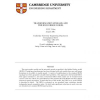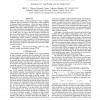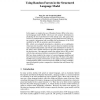187 search results - page 17 / 38 » A Markov Random Field Model for Automatic Speech Recognition |
CSL
2002
Springer
13 years 7 months ago
2002
Springer
The most popular model used in automatic speech recognition is the hidden Markov model (HMM). Though good performance has been obtained with such models there are well known limit...
MLMI
2007
Springer
14 years 1 months ago
2007
Springer
Eye gaze and gesture form key conversational grounding cues that are used extensively in face-to-face interaction among people. To accurately recognize visual feedback during inter...
ICASSP
2011
IEEE
12 years 11 months ago
2011
IEEE
Current hidden Markov acoustic modeling for large vocabulary continuous speech recognition (LVCSR) relies on the availability of abundant labeled transcriptions. Given that speech...
NIPS
2004
13 years 9 months ago
2004
In this paper, we explore the use of Random Forests (RFs) in the structured language model (SLM), which uses rich syntactic information in predicting the next word based on words ...
CIARP
2009
Springer
13 years 5 months ago
2009
Springer
Abstract. Region-based approaches have been proposed to computerassisted colorization problem, typically using shape similarity and topology relations between regions. Given a colo...



